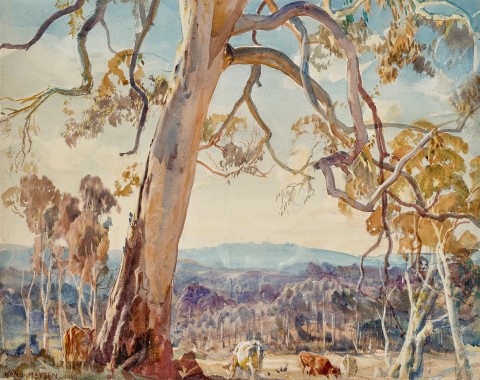The white gum, 1945
Hans Heysen
watercolour on paper
32.0 x 40.5 cm
signed and dated lower left: HANS HEYSEN 1945
bears inscription with title, artist and ref. W-93-DH.H. on label verso, signed by David Heysen
Probably: David Heysen, Adelaide
Private collection, Adelaide
Private collection, Melbourne
Menzies, Sydney, 1 December 2021, lot 68
Private collection, Sydney
Landscape, Five Fifty Art Advisory, Melbourne, 6 May - 3 July 2021, cat. 11 (label attached verso)
We are grateful to Allan Campbell, Curator of the Heysen Collections, Hahndorf, for his assistance with this catalogue entry.
Hans Heysen’s prodigious talent was recognised early to the extent that in 1899, at the age of twenty-two, four South Australian patrons made a gift to £400 enabling him to study in Europe for four years. Upon his return, the results were immediately apparent with the Art Gallery of New South Wales purchasing The coming home, 1904, followed by Heysen’s first Wynne Prize for landscape painting that same year. He also married one of his students, Selma Bartels. In 1908, the couple (now with two daughters) moved to rented premises in Hahndorf in the Adelaide Hills. Four years later, they purchased ‘The Cedars’, a sprawling property of thirty-six acres filled with thousands of gum trees, a great number of which became central to his paintings – with the artist often returning over time to chart the changing effects of light upon them as they aged. Here he built a bespoke studio, which remains standing today as the oldest surviving example in Australia. Employing his European studies as foundation, Heysen was thus able to ‘(render) the gum tree familiar; they are like oak trees, solid, reliable citizens of the countryside.’1 The white gum, 1945, features one of these majestic trees, identified by Allan Campbell, Curator of the Heysen Collections, as being one of the artist’s ‘favoured Manna gums looking north from his property’2, here providing shade for grazing cattle, set against a background vista of scrubby forest and hills.
Heysen never forgot his first patrons’ generosity nor the faith they had in his skills, and he remained a dedicated and prodigious artist to the end of his long life. He also took great pride in the success of his daughter Nora whose training was largely under the benevolent gaze of her father. Heysen was also a master draughtsman and his disciplined, yet sensitive, drawings provided the armature for his equally impressive watercolours. Indeed, of the nine Wynne Prizes he would eventually win, five were watercolours. It is ‘the medium of the light touch’3, unlike oil paint, which can be layered and mixed over time. Watercolours, once dry, resist later alterations so the artist must get the colour and the stroke correct the first time. This is particularly evident when studying a work such as The white gum, in the variation of colouring in the trunk of the tree, and in that of the purple-blue hills and bushland; these are skills honed over decades of practice, to which art collectors repeatedly responded. A further point of interest is the catalogue number verso on the frame which relates to a nationwide survey conducted by Heysen’s son David in the 1970s, sourcing information on his father’s dispersed works.
The white gum was painted in the final year of World War II, a challenging period for the German-born Heysen who had already endured xenophobia towards him during the Great War. Nora had been a war artist based in Finschhafen, New Guinea, enduring bombing raids as she worked, while her father also suffered a great sadness when one of his oldest friends (one of the original four patrons) died in 1945. The white gum may therefore be considered against such circumstance. As much as the world attempted to tear itself apart, and as friends would inevitably age and die, his beloved trees would survive – sentiments which imbue his mature paintings with a vitality and measured optimism that is impossible to ignore.
1. Plant, M., ‘Render unto the gum tree’, in The real thing, Heide Museum of Modern Art, Melbourne, 1997, p. 56
2. Allan Campbell, Curator of the Heysen Collections, correspondence with Damian Hackett (October 2025)
3. Plant, op. cit., p. 57
ANDREW GAYNOR
